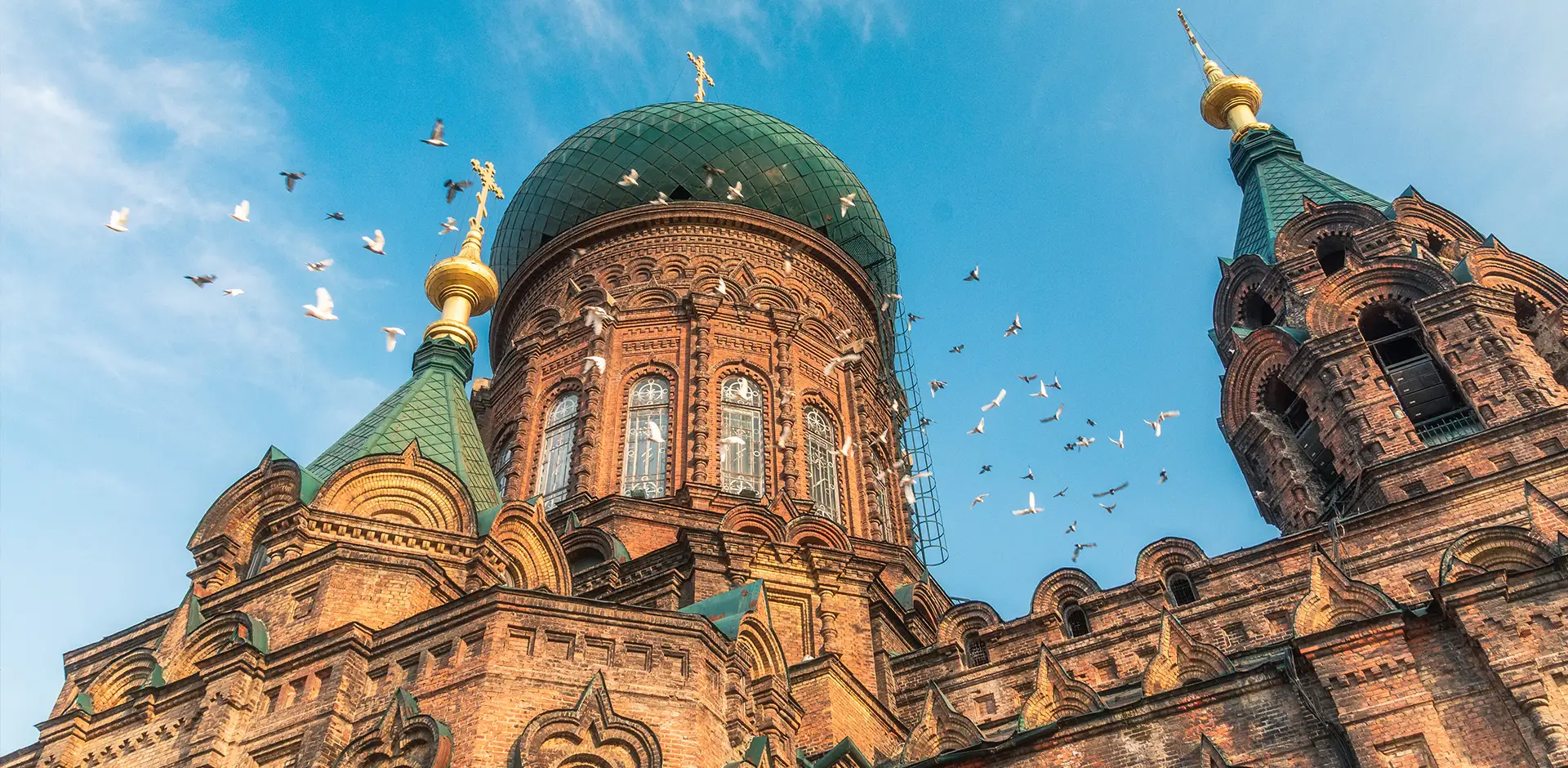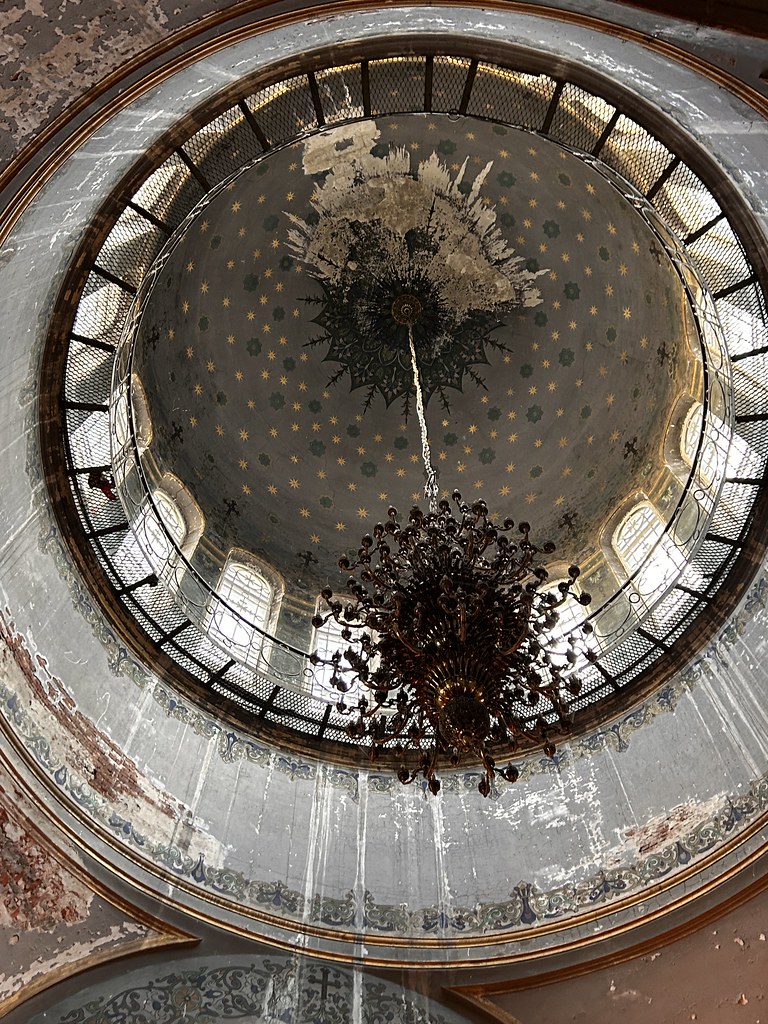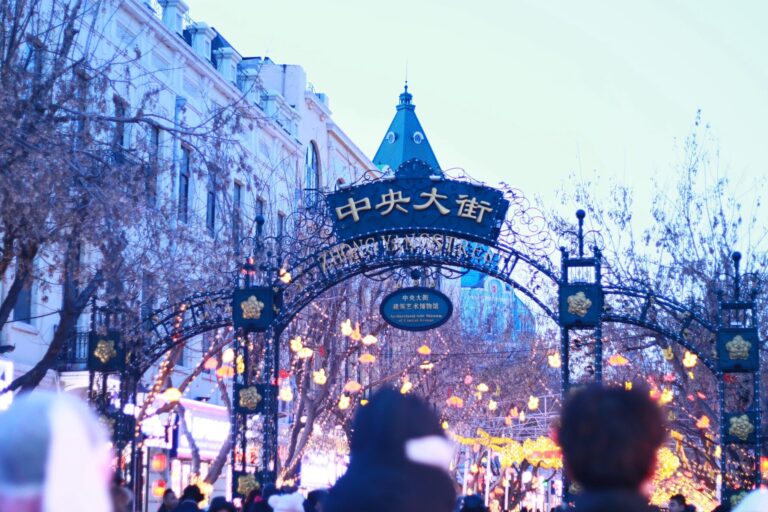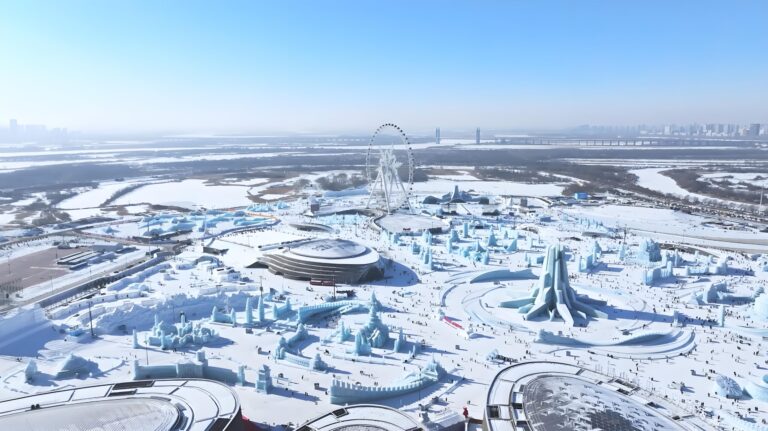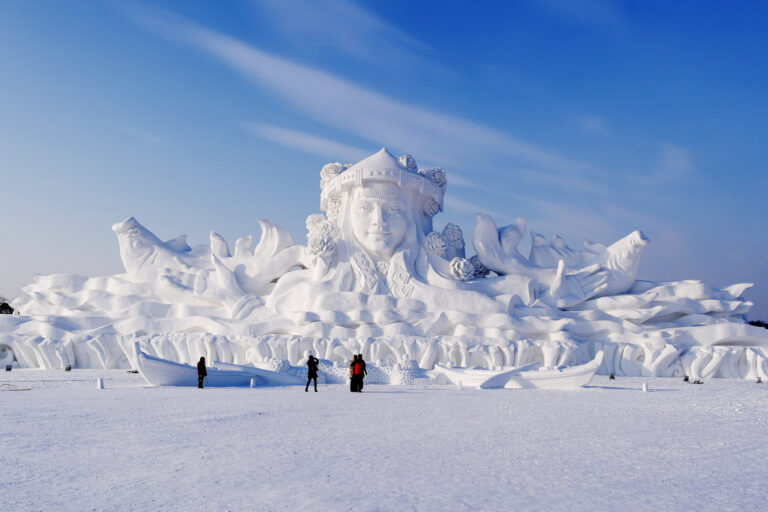Harbin Saint Sophia Cathedral: An Ultimate Insider’s Guide
Welcome to Harbin, the “Moscow of the East.” In the heart of this city stands a breathtaking icon. The Harbin Saint Sophia Cathedral. Its emerald-green onion dome is a beacon of history. It rises against the skyline, a testament to a forgotten era.
We at Travel China With Me have visited countless times. Each visit feels like the first. The sheer scale and beauty of the cathedral always leave us in awe. It’s more than just a building. It’s the soul of Harbin’s unique history captured in brick and mortar. Whether dusted in winter snow or basking in the summer sun, its presence is magnetic.
This guide is built from our own experiences and in-depth research. We want to share everything you need to know. We will help you plan the perfect visit to this architectural masterpiece. Let’s explore the story, the beauty, and the secrets of the Harbin Saint Sophia Cathedral together.
Quick Facts
Official Name: Harbin Architectural Art Gallery
Chinese Name: 圣索菲亚大教堂
Location: 88 Toulong Street, Daoli District, Harbin, Heilongjiang, China
Year Built: Originally 1907; Rebuilt and expanded 1923-1932
Architectural Style: Neo-Byzantine
Height: 53.3 meters (175 feet)
Current Function: Museum and art gallery. It is no longer a functioning church.
Best For: History buffs, architecture lovers, photographers, cultural explorers.
Key Feature: The massive, iconic green “onion” dome.
It is the largest Orthodox church in the Far East.
Table of Contents
A Story of Empires: History and Cultural Significance
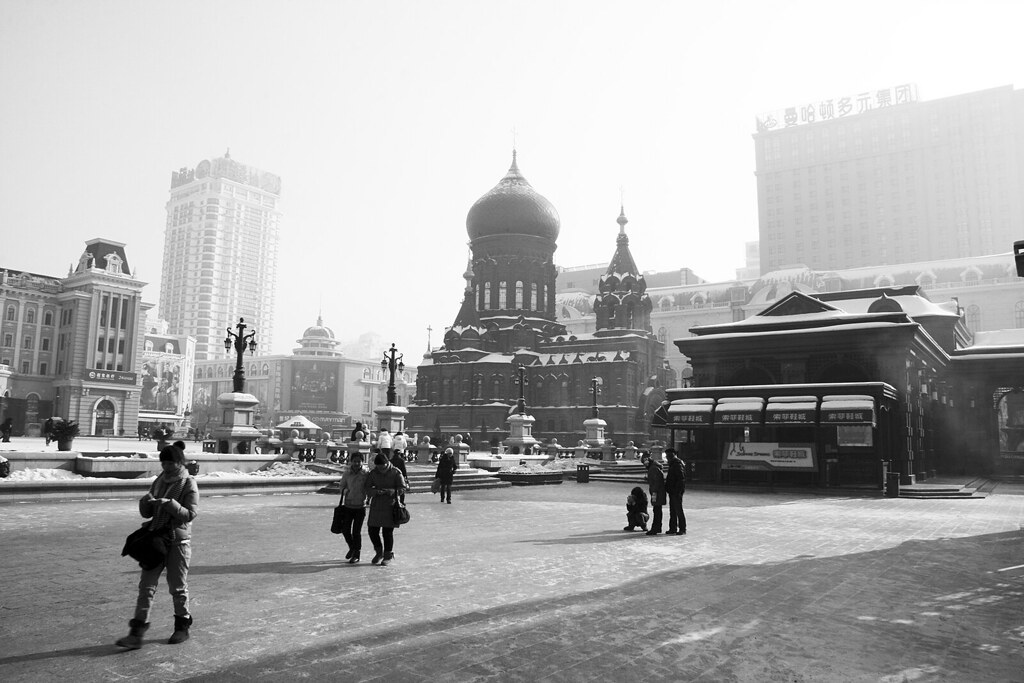
The story of the Harbin Saint Sophia Cathedral is the story of Harbin itself. It’s a tale of empires, railways, revolution, and resilience. Understanding its past will transform your visit from simple sightseeing into a deep, historical journey.
The Russian Beginning (1907-1917)
Why is there a massive Russian church in Northeast China? The answer lies with the Chinese Eastern Railway. In the late 19th and early 20th centuries, Imperial Russia expanded its influence into Manchuria. They built a grand railway to connect to their port at Vladivostok. Harbin became the administrative hub for this project.
Thousands of Russian soldiers, engineers, and merchants flocked to the city. They needed a spiritual home. In March 1907, a modest timber church was quickly built for the 4th Infantry Division. This was the first version of Saint Sophia. It was a simple structure, meant to serve the immediate needs of the troops. But it planted the seeds for something much grander.
The Grand Reconstruction (1923-1932)
After the Russian Revolution of 1917, a new wave of Russians arrived in Harbin. These were the “White Russians,” fleeing the Bolshevik regime. They brought their culture, skills, and faith with them. Harbin’s Russian population swelled. The small wooden church was no longer adequate.
In 1923, a massive fundraising effort began to expand the cathedral. The project was ambitious and took nine years to complete. The final structure, finished in 1932, is the magnificent cathedral we see today. Designed by Russian architect Mikhail M. Oskopov, it was a masterpiece of Neo-Byzantine design. For years, it was the spiritual heart of the Orthodox community in the Far East. Its bells chimed across a city that was a unique blend of Chinese and Russian cultures.
A Period of Silence (1950s – 1980s)
The cathedral’s vibrant life was short-lived. Following the establishment of the People’s Republic of China, most of the Russian population left Harbin. The church slowly fell into disuse. Its doors were closed for services in 1958.
Worse was to come during the Cultural Revolution (1966-1976). Religious sites were seen as relics of imperialism and feudalism. The cathedral suffered damage. Crosses were torn down. Its beautiful murals and icons were covered or destroyed. For decades, it was repurposed as a warehouse for a local department store. It was completely hidden from view, surrounded by concrete apartment blocks. An entire generation grew up in Harbin without even knowing this gem existed in their city’s heart.
Rebirth and Recognition (1990s – Present)
By the 1990s, China began to recognize the value of its unique historical landmarks. In 1996, the Harbin Saint Sophia Cathedral was listed as a National Key Cultural Relic. This marked a turning point.
The government invested heavily in its restoration. The drab buildings that had hidden it for decades were demolished. A new public space, Sophia Square, was created around it. The exterior was meticulously repaired to its former glory.
In 1997, it reopened to the public. But it was not a church anymore. It was reborn as the Harbin Architectural Art Gallery. Today, it stands as a proud symbol of Harbin’s cosmopolitan past. It is a protected monument, cherished by locals and visitors alike. It reminds everyone of the city’s incredible journey through history.
Why is the Saint Sophia Cathedral Worth a Visit?

On our first trip to Harbin, our local colleague, Mr. Zhang, told us, “You haven’t seen Harbin until you’ve seen Sophia.” He was right. This landmark is the emotional and historical anchor of the city.
- A Photographer’s Dream: The building is stunning from every angle. Its red brick walls contrast beautifully with the green dome. In winter, snow turns it into a scene from a fairy tale. At night, it’s illuminated with golden light, creating a romantic atmosphere.
- A Portal to the Past: Standing in Sophia Square, you can feel the history. You are standing at the crossroads of Chinese and Russian history. The cathedral is a physical link to Harbin’s unique identity as the “Moscow of the East.”
- Architectural Marvel: You don’t need to be an expert to appreciate its design. The sheer scale of the dome, the intricate brickwork, and the soaring bell tower are awe-inspiring. It’s a perfect example of Byzantine style, rarely seen in this part of the world.
- The Heart of the City: Sophia Square is a lively public space. You can watch locals dance, see children feeding pigeons, and feel the city’s pulse. It’s a place to relax and soak in the local atmosphere.
- Unique Cultural Context: It tells a powerful story of cultural exchange and integration. It also speaks to the preservation of heritage in modern China. Its transformation from a sacred space to a public museum is a fascinating chapter in its history.
Architectural Highlights: What to Look For
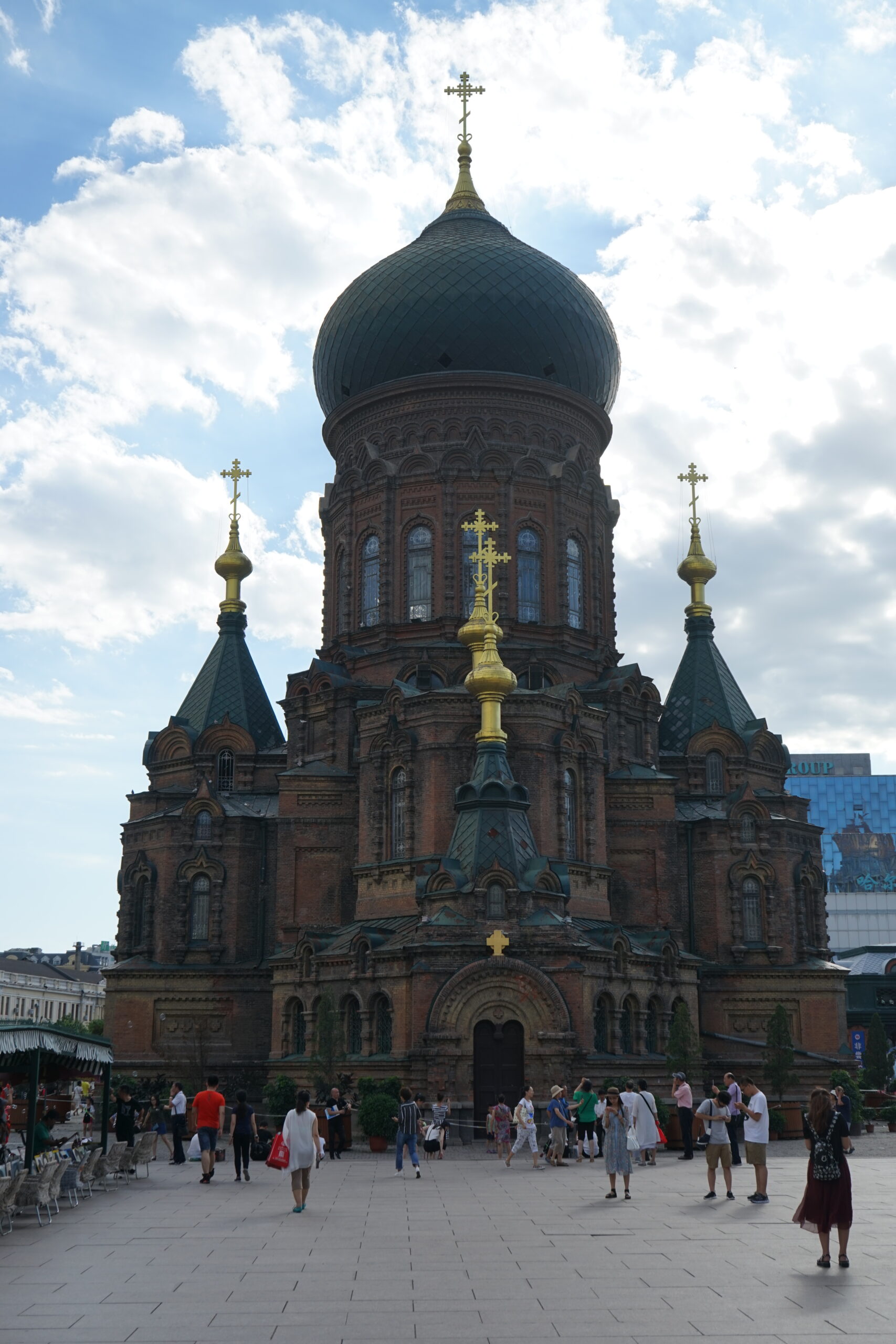
When you visit, take your time to appreciate the details. The cathedral’s design is rich with symbolism and masterful craftsmanship. Our team always finds something new to admire with each visit.
The Magnificent Exterior
Your first impression will be of the cathedral’s immense size and striking colors. The walls are made of rich, red brick. This style is typical of Russian architecture from the period.
Look closely at the brickwork. You’ll notice intricate patterns and decorative elements. The architects used these details to break up the massive walls. This creates a sense of elegance and complexity.
The main entrance is framed by a grand arch. Above it, you can see a depiction of Christ. Though weathered, it hints at the building’s original sacred purpose. The windows are tall and arched, typical of church design, letting in light while drawing the eye upwards.
The Iconic Onion Dome
The star of the show is the central dome. This is a classic feature of Russian Orthodox churches. It is often called an “onion dome” because of its shape. The dome of Saint Sophia is enormous and covered in beautiful emerald-green copper tiles. It stands 53.3 meters tall, dominating the square.
This central dome is not alone. It is surrounded by four smaller tent-roofed towers. Each is topped with a golden Orthodox cross. This arrangement creates a beautiful, balanced silhouette. The design is meant to draw the worshipper’s gaze up towards the heavens.
The Bell Tower
To the left of the main entrance stands the bell tower. It is a tall, elegant structure that perfectly complements the main building. The original seven bells were cast in Russia. They were rung by a trained bell-ringer on important religious holidays.
Today, the bells are silent. But the tower itself remains a key feature. It is a reminder of the sounds that once filled this neighborhood. Imagine the deep, resonant chimes calling the faithful to prayer over a century ago.
Inside the Cathedral: The Architectural Art Gallery
Stepping inside is a different experience. The religious artifacts are gone. The space has been transformed into a museum. But the architectural grandeur remains.
Look up immediately. The sheer height of the interior is breathtaking. The massive dome looms high above the central hall. Light streams in from the windows high up in the dome’s drum. This creates a vast, open, and airy feeling.
The main exhibition is the “Harbin Architectural Art Gallery.” It features a large collection of black and white photographs. These photos document Harbin’s history. You can see what the city looked like in the early 20th century. There are pictures of Zhongyang Avenue, the Songhua River, and, of course, the cathedral itself.
While most of the original frescoes and religious icons were destroyed, small sections have been restored. Look carefully at the high walls and ceilings. You can see faded remnants of the original paintings. These ghostly images offer a poignant glimpse into the cathedral’s former life as a vibrant place of worship. They are a powerful reminder of what was lost.
A Special Experience: The Magic of Sophia Square
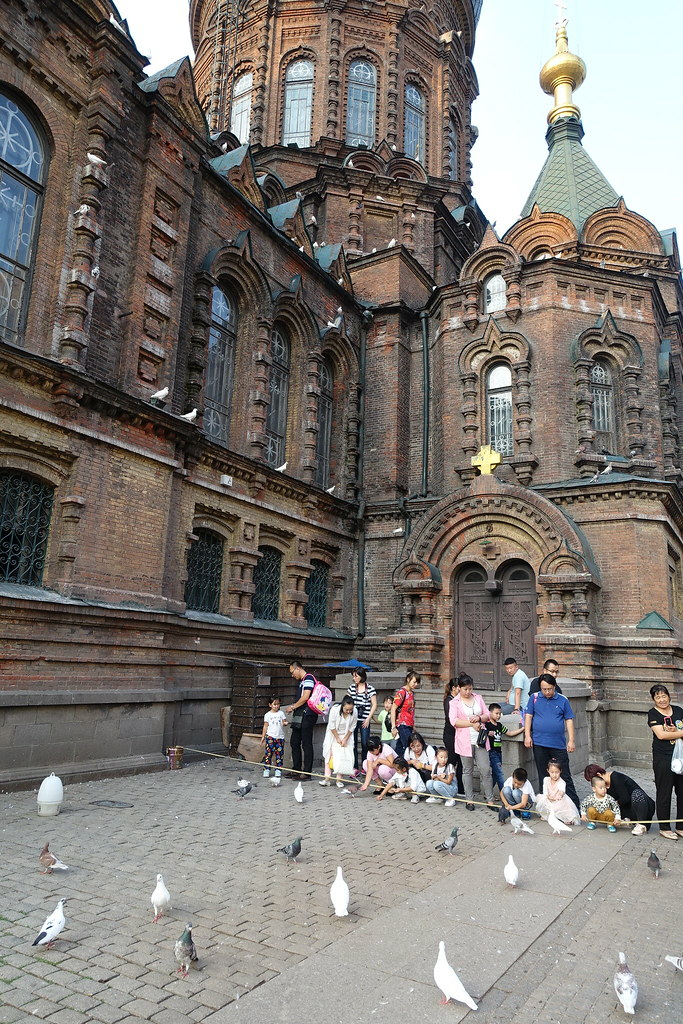
The experience of the Harbin Saint Sophia Cathedral extends beyond its walls. Sophia Square (索菲亚广场, Suǒfēiyà Guǎngchǎng) is an essential part of the visit. It is where the building connects with the city and its people.
Our favorite time to visit is just before sunset. Find a bench and just watch.
As the sun goes down, the atmosphere changes. The crowds grow. Hundreds of pigeons, a famous feature of the square, flock and flutter. You can buy a small bag of birdseed from local vendors. It’s a simple joy to have them land on your hands and shoulders. Kids and adults alike delight in this interaction.
Then, as dusk settles, the magic happens. The floodlights switch on. The entire cathedral is bathed in a warm, golden glow. The green dome seems to shine from within. The building transforms from a historical monument into a dramatic, romantic centerpiece.
In winter, this experience is even more magical. The steam from your breath hangs in the freezing air. The cathedral is often covered in a delicate layer of frost or snow. The warm lights against the cold, white landscape create an unforgettable scene. It feels like you’ve stepped into a Christmas card.
Sometimes, local musicians will play on the square. We once enjoyed a beautiful saxophone performance on a crisp winter evening. The music echoed across the square, adding to the enchanting ambiance. This is the living culture of Harbin, and the cathedral is its backdrop.
How to Visit: A Step-by-Step Walkthrough
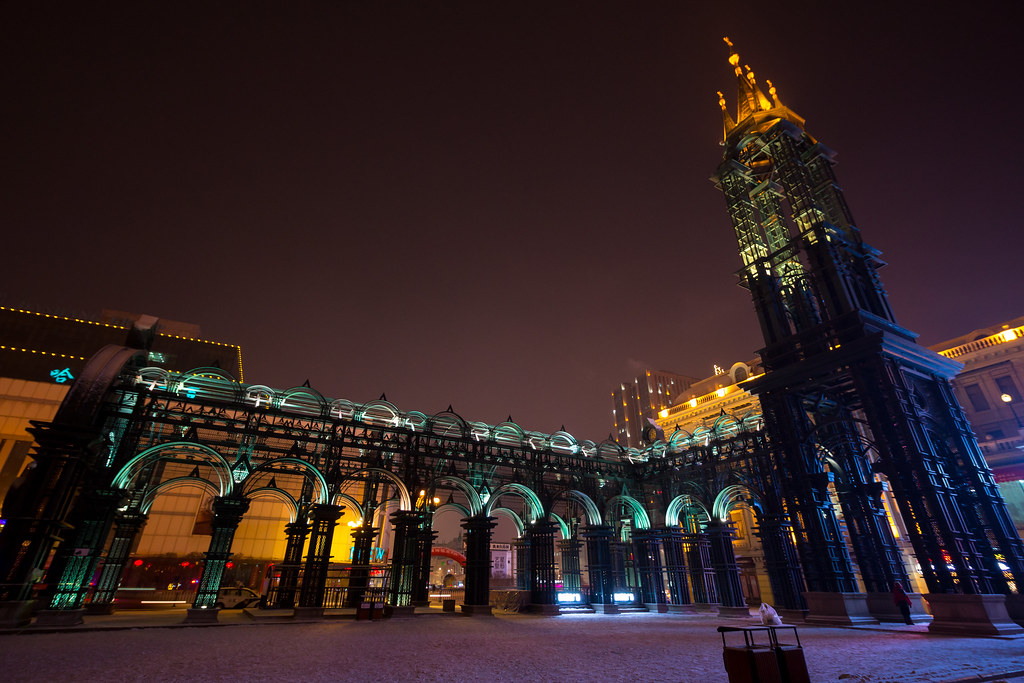
Visiting the cathedral is straightforward. Here’s how we recommend you approach it to make the most of your time.
- Arrive at the Square: Whether you come by taxi or metro, you’ll first enter the vast Sophia Square. Take a moment to see the cathedral from a distance. Appreciate its scale and how it fits into the cityscape.
- Walk the Perimeter: Before going inside, walk a full circle around the building. Each side offers a different perspective and different details. This is the best way to appreciate the full scope of the architecture.
- Purchase Your Ticket: The ticket office is a small booth near the main entrance. As of our last visit, lines are usually short, but it’s good to have cash (RMB) ready, though mobile payments are common.
- Explore the Interior: Head inside. Your ticket allows you to enter the main hall, which now houses the photo exhibition. Plan for about 30-45 minutes to see the photos and admire the interior structure. Read the captions on the photos to understand Harbin’s urban development.
- Enjoy the Square: After you exit, spend time in the square itself. This is where you can take your best photos. Try different angles. Get a low shot looking up at the dome. Capture the pigeons in flight.
- Visit at Night: If you can, we strongly recommend returning after dark. The illuminated cathedral is a completely different sight. It’s worth a second, shorter visit just for the nighttime view.
Best Time to Visit Harbin Saint Sophia Cathedral
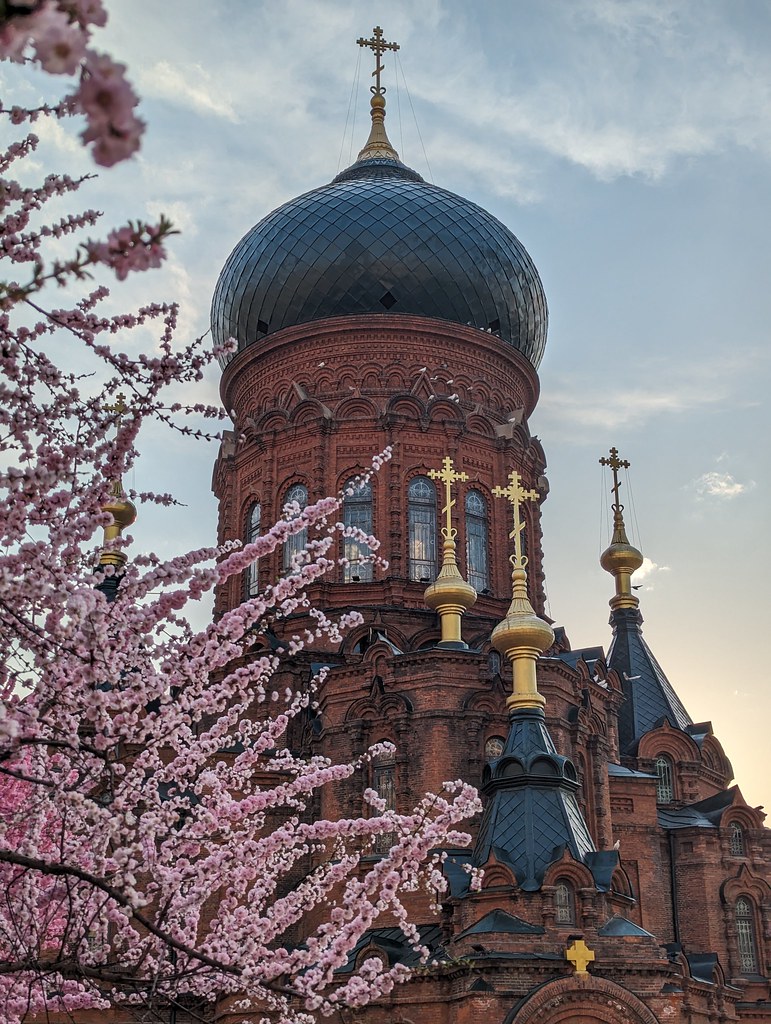
The cathedral is a year-round destination. The best time to visit really depends on what you want to experience.
Winter (December to February)
This is the classic Harbin experience. The city is famous for its Ice and Snow Festival.
- Pros: The cathedral looks absolutely magical covered in snow. It’s the picture-perfect “winter wonderland” scene. The cold, crisp air adds to the Russian atmosphere.
- Cons: It is extremely cold. Temperatures can drop to −30℃ (−22℉). You need to be well-prepared with proper winter gear. Crowds can be large due to the Ice Festival.
Summer (June to August)
Summer in Harbin is pleasant and warm. The city is green and full of life.
- Pros: The weather is comfortable for walking around. The square is lively with locals enjoying the long daylight hours. You can comfortably spend a long time outside.
- Cons: You won’t get the iconic snowy photos. It can be busy with domestic summer tourists.
Spring and Autumn (April-May, September-October)
These shoulder seasons are a fantastic compromise.
- Pros: The weather is mild and pleasant. There are fewer crowds than in peak seasons. Autumn offers beautiful colors in the city’s parks.
- Cons: The weather can be unpredictable. You miss the extremes of either the snow or the summer vibrancy.
Best Time of Day
- Morning (9:00 AM – 11:00 AM): Good light for photography and usually less crowded.
- Late Afternoon to Evening (4:00 PM onwards): Our recommended time. You can see the cathedral in daylight, watch the sunset, and then witness the magical lighting ceremony.
Planning Your Visit: The Practical Details
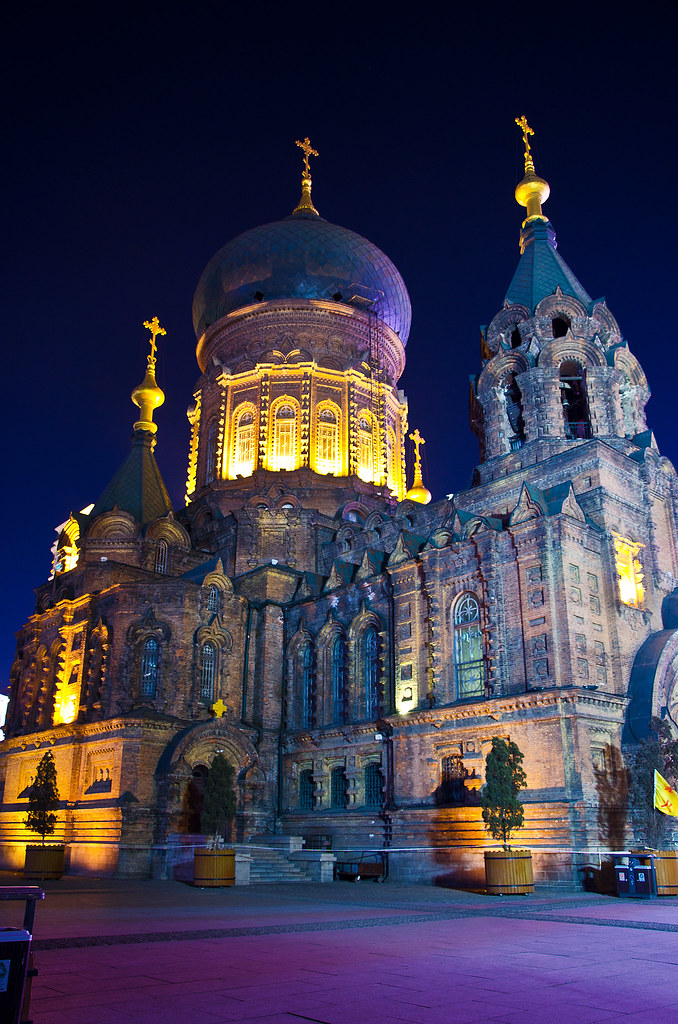
Getting the logistics right is key to a smooth trip. Here is the essential information, updated for 2025. Please note that prices and times can change, so it’s always wise to double-check locally.
Getting There
The cathedral is centrally located in the Daoli District and is very easy to reach.
- By Metro: This is often the most convenient option. Take Harbin Metro Line 2 to Zhongyang Dajie Station (中央大街站). Use Exit 3. From there, it is about a 10-15 minute walk. The walk itself is interesting, taking you through the heart of the city.
- By Bus: Many public bus routes stop near Sophia Square. Look for buses stopping at “Sophia Square Station” (索菲亚广场站). Routes include 1, 5, 20, 61, 85, 113, and 114.
- By Taxi or Didi: Taxis are plentiful. Simply show the driver the name in Chinese: 圣索菲亚大教堂 (Shèng Suǒfēiyà Dàjiàotáng). This is the easiest, though not always the fastest, way if you are not near a metro station.
Opening Hours and Tickets
Category | Details |
|---|---|
Sophia Square | Open 24/7, free of charge. |
Cathedral Interior | Approximately 8:30 AM – 5:00 PM daily. |
Ticket Price (Interior) | ¥15 – ¥20 RMB per person (subject to change). |
Ticket Purchase | At the ticket booth on the square. Cash and mobile payments (WeChat/Alipay) accepted. |
Important Note: Hours may be adjusted during public holidays. We advise checking with your hotel or a local guide for the most current information upon your arrival in Harbin.
Practical Travel Tips from Our Team
After many visits, we’ve gathered some insider tips to make your experience even better.
- Dress for the Season: In winter, this is not a suggestion—it’s a requirement for survival! Wear thermal layers, insulated and waterproof pants, a heavy-duty parka, a warm hat that covers your ears, a scarf or face mask, and insulated, waterproof boots. Hand and foot warmers are a lifesaver.
- Battery Power: The extreme cold in winter will drain your phone and camera batteries incredibly fast. Keep them in an inside pocket close to your body heat. Bring a portable power bank.
- Combine with Zhongyang Avenue: The famous Zhongyang Dajie (Central Avenue) is just a short walk away. This historic, pedestrian-only street is lined with more Russian architecture, shops, and restaurants. Plan to visit the cathedral and then take a leisurely stroll down this beautiful avenue.
- Try Local Snacks: You’ll find vendors on the square selling Harbin specialties. In winter, try a candied hawthorn stick (冰糖葫芦, bīngtánghúlu) or a roasted sweet potato. In summer, the Madieer (Modern) ice cream is a must-try Harbin classic.
- Photography Tip: For a unique photo, stand back and include the modern skyscrapers in the background. The contrast between the historic cathedral and the modern city tells a powerful story.
Real Traveler Reviews: What Visitors Are Saying
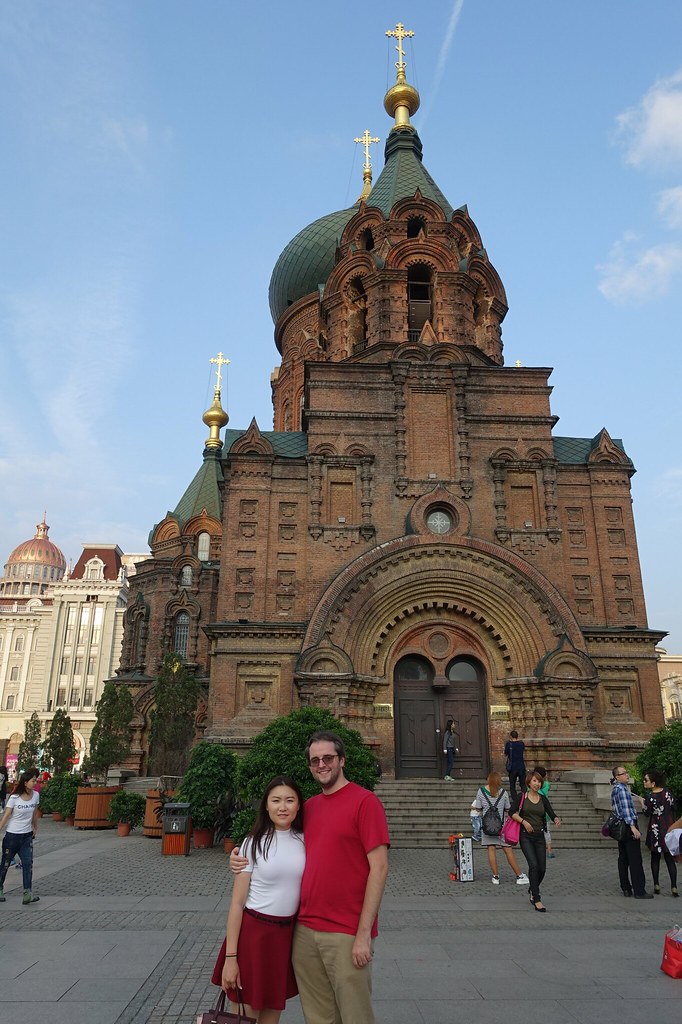
We believe in honest feedback. Here are some paraphrased reviews that reflect the typical visitor experience, based on common sentiments shared online and in person.
“The highlight of my Harbin trip. I went in January, and seeing it covered in snow was like something from a movie. It was freezing cold, but worth every second. Don’t miss seeing it lit up at night!” – Sarah from Australia
“The outside is a 10/10. Absolutely stunning architecture. The inside was a bit of a letdown for me. I was expecting a grand church interior, but it’s just a photo gallery. It’s still worth the small entry fee to see the scale of the dome from below, but manage your expectations.” – Mark from the USA
“A beautiful square and a piece of European history in China. We loved feeding the pigeons and just sitting on a bench watching the world go by. It’s a very relaxing place despite being in the middle of a big city.” – Isabelle from France
Frequently Asked Questions (FAQ)
Here are direct answers to the most common questions we get from travelers.
1. Is Saint Sophia Cathedral still an active church?
No, it is no longer a functioning place of worship. It was deconsecrated and is now officially the Harbin Architectural Art Gallery, a municipal museum.
2. How much time should I spend at the cathedral?
We recommend planning for 1.5 to 2 hours. This gives you enough time to explore the exterior, visit the gallery inside, and enjoy the atmosphere of Sophia Square without rushing.
3. Is it worth paying to go inside?
This depends on your interests. The exterior is arguably the most impressive part. However, we believe the small entrance fee (around ¥20 RMB) is worth it to experience the immense scale of the interior and see the historical photos which provide great context about the city.
4. Is the area around the cathedral safe?
Yes, it is very safe. Sophia Square is a popular public area and is well-lit and monitored. As in any busy tourist spot, just be mindful of your personal belongings.
5. Can I take photos inside?
Yes, photography is generally permitted inside, but using a flash may be discouraged. Be respectful of the exhibits and other visitors.
6. Are there restrooms available?
Yes, there are public restroom facilities located on the edges of Sophia Square.
A Personal Note from Our Team
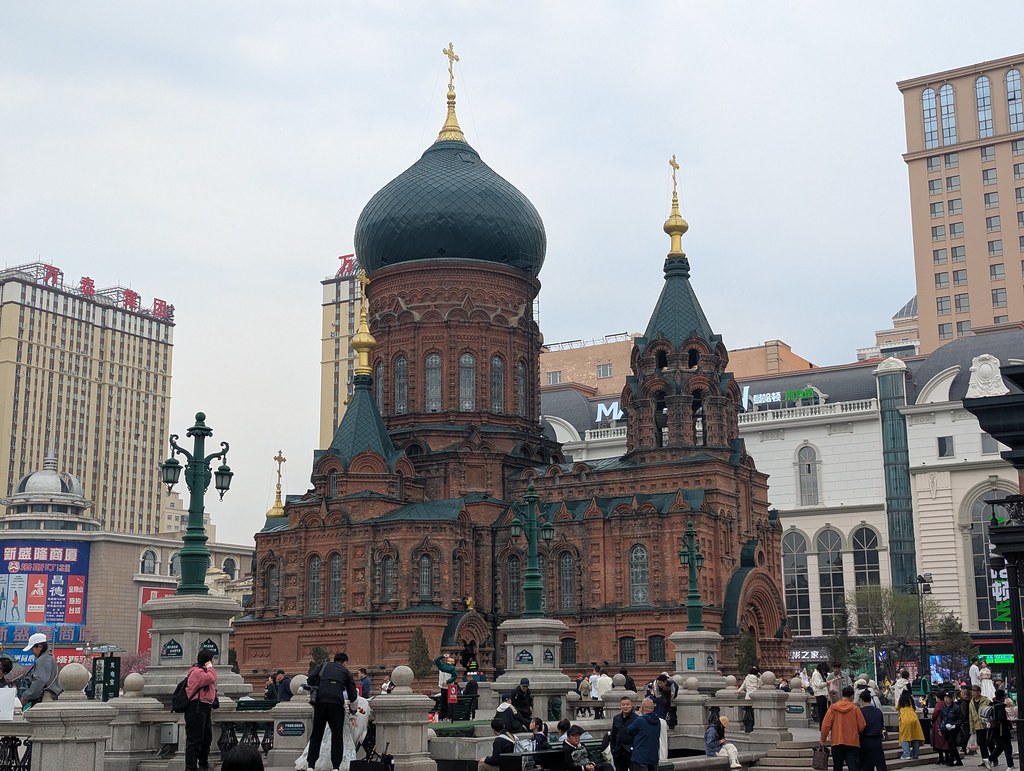
The Harbin Saint Sophia Cathedral holds a special place in our hearts. It was one of the first places in China that truly surprised us. We expected ancient temples and imperial palaces, but we found a piece of Tolstoy’s Russia standing proudly in Heilongjiang.
For us, the cathedral is a powerful symbol. It’s a reminder that China is a country of immense diversity and complex history. It shows how cultures can meet, merge, and create something beautiful and unique. It has survived neglect and near-destruction to become one of Harbin’s most cherished landmarks. Its story is one of incredible resilience.
When you stand in Sophia Square, looking up at that magnificent dome, we hope you feel the same sense of wonder we do. We hope you feel the echoes of history and appreciate the vibrant present. This is more than a tourist attraction. It is the enduring soul of a truly remarkable city.
We are here to help you experience it for yourself. If you have any more questions or want to include Harbin in your China adventure, please don’t hesitate to reach out to us. Travel safely!


